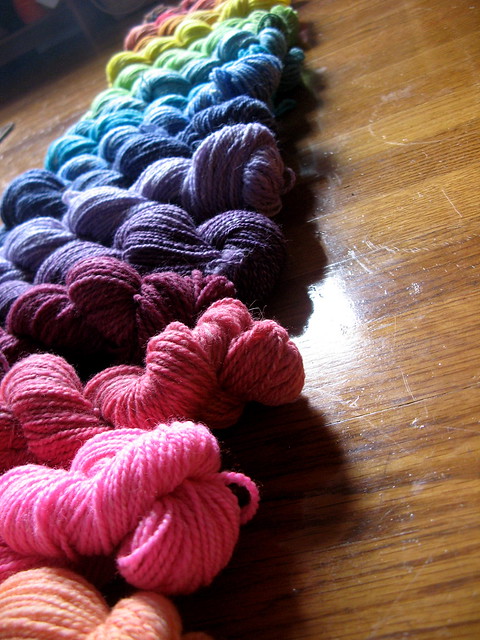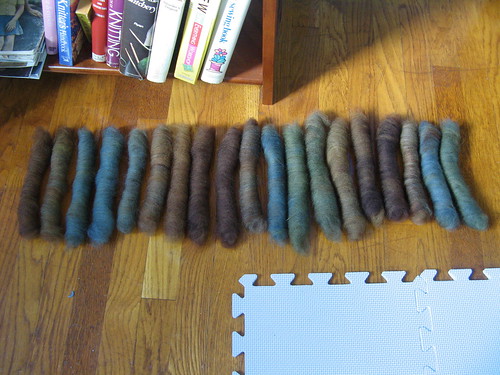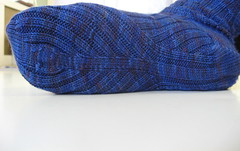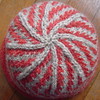Spinning Along
I don't often do spin and knitalongs. I usually like to do what I want, when I want, and at my own pace. But this summer things worked out such that my plans coincided nicely with spinalong plans, or were just fuzzy enough that I could fit what I wanted to do into the scope of organized group efforts. It feels really nice to occasionally break away from being a completely independent crafter, and to participate in a group challenge.
My big, huge, I-Can't-Believe-I-Spun-The-Whole-Thing challenge was for the Tour De Fleece, earlier this summer. My personal goal was to spin up half the fiber I bought for a blanket project. I got 20% of it done before the challenge started, and ended up finishing the remaining 80% during the Tour. Whoa! I still can't quite fathom how I managed that. The time limit and group sharing was definitely a motivator to push myself and keep on going.

It started out as two Spunky Eclectic Almost Solid samplers, in the wool blend.

I had 2 oz. each of 20 different colors. I spun and plied each color into its own little 2-ply skein of yarn.

To make things more streamlined, I worked in groups of four colors. I spun four colors onto one bobbin, and the same four colors, in the same order, onto a second bobbin. That allowed me to spin and ply without having to change bobbins after every ounce.

I found the wool blend very easy to spin, and it yielded a lofty yarn, even when spun worsted from combed top. It was a little neppy, but nothing too bad, and I was able to pick out the occasional nep as I went. Overall, I think it's a very nice fiber for the price, and was a good choice for this project.

The final stats on the yarn:
20 ~2 oz. 2-ply skeins
total length: 2920 yards
total weight: 1132 grams (40 oz, or 2.5 pounds)
yards per pound: 1155
average skein length: 146 yd.
average skein weight: 56.6 g. (2 oz.)
12-13 wraps per inch, for the most part

It's going to be a beautiful log cabin blanket. I haven't cast on, yet, but I'm really looking forward to it.
My other spin-along projects are for the Four Ounce Challenge being put on by Adrian (Hello Yarn), David (Southern Cross Fibre), and Amy (Spunky Eclectic). The challenge is to spin, and then knit, crochet, or weave a project from 4 oz. of their yarn. Bonus points if you create an original design and publish the pattern. My own personal theme for this challenge is rolags and woolen spinning.

That's Hello Yarn's 5 Plum Pie colorway. I've spun up the colors separately, into very lofty two ply yarns.

I had hoped to use it for colorwork, but being woolen (and me being out of practice spinning woolen!), the yarns are too uneven for that to work well. So I will go with something simpler. I am still really happy with my original design idea, and just ordered some Malabrigo worsted for it. The Malabrigo hat won't be eligible for the spinalong contest, but that's okay. Anything that inspires a new design is fine by me!
My other project for this contest has also had its troubles.
The fun part was turning this:

into this:

(just a sampling of the rolags)
Unfortunately, in my haste to start spinning, I didn't properly sample, and am ending up with a yarn that is much thinner than I intended. I wanted to go for fingering weight singles for a lace shawl or scarf. I'm ending up with a much thinner yarn, and I don't think I'll have time to knit that up by the contest deadline. I'm considering chain plying it to maintain the colors. Chain plying is not idea for woolen spun yarns because they tend to be less even than worsted spun yarns. While a traditional three (or other) ply will help even out uneven singles, chain plying only serves to enhance the unevenness. But I may try it anyway, and see what I get. If nothing else, it's a learning experience.
Making rolags from combed top is very easy and a lot of fun. When you work from a multicolored top, you get beautifully heathered rolags that turn into a beautifully heathered yarn. I am quite tempted to buy a sweater's worth of multicolor top from one of my favorite dyers, and spin it up using this technique. I think that it does dull some of the contrasts and transitions, which could be nice for a multicolor sweater. Another project for the long, long wishlist.
My big, huge, I-Can't-Believe-I-Spun-The-Whole-Thing challenge was for the Tour De Fleece, earlier this summer. My personal goal was to spin up half the fiber I bought for a blanket project. I got 20% of it done before the challenge started, and ended up finishing the remaining 80% during the Tour. Whoa! I still can't quite fathom how I managed that. The time limit and group sharing was definitely a motivator to push myself and keep on going.

It started out as two Spunky Eclectic Almost Solid samplers, in the wool blend.

I had 2 oz. each of 20 different colors. I spun and plied each color into its own little 2-ply skein of yarn.

To make things more streamlined, I worked in groups of four colors. I spun four colors onto one bobbin, and the same four colors, in the same order, onto a second bobbin. That allowed me to spin and ply without having to change bobbins after every ounce.

I found the wool blend very easy to spin, and it yielded a lofty yarn, even when spun worsted from combed top. It was a little neppy, but nothing too bad, and I was able to pick out the occasional nep as I went. Overall, I think it's a very nice fiber for the price, and was a good choice for this project.

The final stats on the yarn:
20 ~2 oz. 2-ply skeins
total length: 2920 yards
total weight: 1132 grams (40 oz, or 2.5 pounds)
yards per pound: 1155
average skein length: 146 yd.
average skein weight: 56.6 g. (2 oz.)
12-13 wraps per inch, for the most part

It's going to be a beautiful log cabin blanket. I haven't cast on, yet, but I'm really looking forward to it.
My other spin-along projects are for the Four Ounce Challenge being put on by Adrian (Hello Yarn), David (Southern Cross Fibre), and Amy (Spunky Eclectic). The challenge is to spin, and then knit, crochet, or weave a project from 4 oz. of their yarn. Bonus points if you create an original design and publish the pattern. My own personal theme for this challenge is rolags and woolen spinning.

That's Hello Yarn's 5 Plum Pie colorway. I've spun up the colors separately, into very lofty two ply yarns.

I had hoped to use it for colorwork, but being woolen (and me being out of practice spinning woolen!), the yarns are too uneven for that to work well. So I will go with something simpler. I am still really happy with my original design idea, and just ordered some Malabrigo worsted for it. The Malabrigo hat won't be eligible for the spinalong contest, but that's okay. Anything that inspires a new design is fine by me!
My other project for this contest has also had its troubles.
The fun part was turning this:

into this:

(just a sampling of the rolags)
Unfortunately, in my haste to start spinning, I didn't properly sample, and am ending up with a yarn that is much thinner than I intended. I wanted to go for fingering weight singles for a lace shawl or scarf. I'm ending up with a much thinner yarn, and I don't think I'll have time to knit that up by the contest deadline. I'm considering chain plying it to maintain the colors. Chain plying is not idea for woolen spun yarns because they tend to be less even than worsted spun yarns. While a traditional three (or other) ply will help even out uneven singles, chain plying only serves to enhance the unevenness. But I may try it anyway, and see what I get. If nothing else, it's a learning experience.
Making rolags from combed top is very easy and a lot of fun. When you work from a multicolored top, you get beautifully heathered rolags that turn into a beautifully heathered yarn. I am quite tempted to buy a sweater's worth of multicolor top from one of my favorite dyers, and spin it up using this technique. I think that it does dull some of the contrasts and transitions, which could be nice for a multicolor sweater. Another project for the long, long wishlist.










